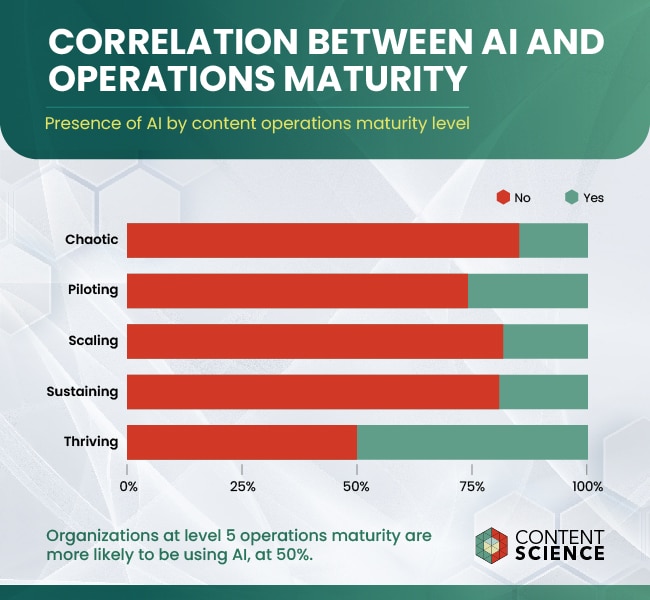
Generative artificial intelligence (AI) and content creation still dominate headlines and attention. And the potential for generative AI to enable creating content at scale is still exciting. But this technology alone is far from a panacea for all of the content problems at an enterprise undergoing digital transformation. And, in fact, generative AI can cause new problems such as spurring ad-hoc workflows that worsen communication between organizational silos or an overwhelming amount of content to manage, govern, and potentially migrate to new systems.
We’re almost more excited about how other types of artificial intelligence, combined with generative AI, can help achieve true digital transformation at scale than we are about generative AI itself. In particular, we want to steer your attention to three ways AI can advance your organization toward a modern, end-to-end content approach.
We’re offering this insight based on
- Our deep experience with advising on large-scale content initiatives across industries and sectors.
- Our longstanding familiarity with and curiosity about artificial intelligence and machine learning.
- Our ongoing research, now with 700+ leaders and professionals, into success factors for content operations.
With more understanding of these three areas, you’ll be less likely to become disillusioned with generative AI and more equipped to lead your organization to a content approach that works.
Using AI Correlates with Content Maturity and Success
Our research into content operations has examined the use of advanced technology, including AI, since 2014. We have seen a steady increase in adoption of advanced technology and AI, as you might expect. As of our 2023 study, nearly a third of content professionals reported using advanced technology or AI, up 22% from 2021. We anticipate that number will increase for our 2025 study.
What you might not expect is the relationship between using AI or advanced technology, content operations maturity, and content success. We have consistently seen a correlation between using AI / advanced technology and content operations maturity as well as between using that technology and reporting content success. This correlation was strongest in our 2021 study. For instance, this chart shows the correlation between using AI / advanced technology and content operations maturity.

The correlation wasn’t as strong in our 2023 study. We believe the reason is more organizations were trying advanced technology / AI when their content strategy and operations were immature and, consequently, struggled to use it well. But, nevertheless, the correlation was still present.
As part of exploring the use of advanced technology in all of these studies and our work with clients, we identified three areas beyond generating content that can benefit exponentially from AI.
1. Using AI in Content Production + Operations
For large organizations, producing content is about much more than content creation or generation. It’s about the process and operations before, during, and after creating content (what we often call the content lifecycle). AI can advance automation in many areas, including but not limited to
- Workflow, such as tying different types or categories of content to different production and / or approval processes.
- Status, such as automatically changing the status of a content asset from “in review” to “approved” or from “live” to “archived” with the right trigger.
- Adherence to standards, such as automatically assessing a content asset for adherence to brand voice and style, accessibility standards, regulatory requirements, and more.
- Producing asset variations, such as automatically producing different sizes of the same asset for different channels.
- Tagging content assets to make them easier to find or access and more effective for training generative AI.
A variety of content technologies can help in this area, ranging from workflow capabilities added to headless CMS such as Kontent.ai to more automation in assessment tools like Siteimprove. The good news for you is they’re all under pressure to innovate and, consequently, are continuously improving—including incorporating more AI.
2. Using AI in Measurement + Content Intelligence
Our ongoing content operations research has identified measuring content effectiveness, ideally within a system of content intelligence, as a top content success factor. Yet, only about a third of organizations do it. Improving automation of content measurement with the help of artificial intelligence has potential to enable more large organizations to make smarter decisions about content faster and at scale. More specifically, AI can enhance automating
- Advanced analysis, such as finding correlations between content characteristics and key performance indicators (KPIs) or identifying best practices.
- Progressive A/B testing or multivariate testing, in conjunction with generative AI.
- Reporting logistics such as updating dashboards, generating report summaries or digests, and notifying appropriate team members.
- Creation and delivery of insights and tips in context to guide content decisions.
- Sentiment and text analysis of voice of customer data to detect content issues or the role of content in customer experience issues.
And those are just a few examples. We’re seeing interesting advances for measurement and data in the vast landscape of off-the-shelf technologies for content, analytics, voice of customer, and marketing. As a very new example, Sanity recently released AI-fueled creation product that allows you to bring notes, including data, into the creation space so the AI can factor that data into suggestions and QA checks.
(And we’re working to do our part with enhancing the automation and sentiment analysis in ContentWRX.)
Organizations also have the opportunity to use AI to customize and streamline their system of content intelligence. For example, you can more easily automate assembly of insights from a variety of these tools into a useful dashboard, report, or summary to support content decisions.
3. Using AI in Content Personalization + Delivery
The proliferation of AI-generated content is causing what we not-so-lovingly call “the great content clog of 2024.” The influx of assets on the web and social media means content is more difficult for customers or users to discover organically than ever before. So, interest in personalizing content delivery to connect the right customers or users with the right content is the highest we’ve seen in many years.
Artificial intelligence has contributed to the problem of hard-to-find content, but it also can be part of the solution to personalize content delivery by enhancing
- Copilots to enable users to explore content in more intuitive ways than keywords.
- Chat bots to be more dynamic and responsive.
- Suggestions for related content or resources to be more accurate and useful.
- Dynamic display of content to be more relevant to the customer or the context.
For example, Wal-Mart recently released a copilot to their search that allows customers to make requests such as “help me plan a Cinco de Mayo celebration” and receive highly relevant results (from party decorations to beef brisket), across all product categories.
Toward AI-Driven, Content-Led Digital Transformation
As your organization moves forward with digital transformation, do not myopically focus on generative AI. We find that the more a large organization uses generative AI to create content assets, the more that organization needs to use artificial intelligence at scale in content production, content measurement, and content delivery. Otherwise, it’s very difficult to avoid the pitfalls of generative AI and make the most of its potential.
Bringing artificial intelligence into an end-to-end content approach is exactly why we like Pfizer’s recent example, described at Adobe Summit as transforming the content supply chain. Their innovation wasn’t simply about using generative AI to create more assets or to create them faster. Their innovation used AI in production, measurement, and delivery to accelerate bringing products to market. And we think every organization would do well to take Pfizer’s cue about the importance of content. When the new approach launched, Pfizer said this:
Content is at the heart of this transformation.
While AI is driving digital transformation now, content is at the heart of it—and content should lead it.
Events, Resources, + More
The Ultimate Guide to End-to-End Content
Discover why + how an end-to-end approach is critical in the age of AI with this comprehensive white paper.
The Content Advantage Book
The much-anticipated third edition of the highly rated book by Colleen Jones is available at book retailers worldwide. Learn more!
20 Signs of a Content Problem in a High-Stakes Initiative
Use this white paper to diagnose the problem so you can achieve the right solution faster.
Upskill with Content Science Academy
Training for modern content roles through on-demand certifications + courses or live workshops.







Comments
We invite you to share your perspective in a constructive way. To comment, please sign in or register. Our moderating team will review all comments and may edit them for clarity. Our team also may delete comments that are off-topic or disrespectful. All postings become the property of
Content Science Review.